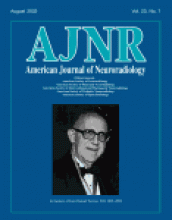Abstract
BACKGROUND AND PURPOSE: P2 segment aneurysms develop between the junction of the posterior communicating artery with the posterior cerebral artery (PCA) and the posterior part of the midbrain in the ambient cistern. We reviewed our experience with parent artery occlusion in such aneurysms, looking for predictors of safety and effectiveness.
METHODS: Clinical and preprocedural data from 10 patients, referred for endovascular treatment of P2 segment aneurysms, were retrospectively studied for prognostic factors influencing postoperative neurologic deficits caused by ischemia of the PCA distal territory. Patient tolerance was assessed by using clinical or anatomic criteria. Embryologic and anatomic features of the PCA were reviewed.
RESULTS: Endovascular parent artery occlusion at the level of the aneurysmal neck was possible in nine cases. Control angiography after embolization showed that the aneurysm did not fill, and the distal PCA refilled via leptomeningeal anastomoses. One asymptomatic aneurysm could not be catheterized because of vascular tortuosity. No neurologic deficit occurred after treatment. Clinical presentations and grades were typical. No embryologic or anatomic configuration (eg, basilar tip arrangement, P2 position relative to the choroidal fissure, aneurysmal size or type [berry, fusiform, or serpentine]) was predictive of bad outcomes.
CONCLUSION: Acute parent artery occlusion appears to be safe in the treatment of P2 segment aneurysms, whatever the location of the occlusion. In our series, potential collateral supply and hemodynamic balance between the anterior and posterior choroidal arteries, pericallosal vessels, and anterior and middle cerebral vessels to the distal PCA made P2 occlusion safe, because the aneurysm occurred after the thalamoperforating vessels arose from the P1 segment.
- Copyright © American Society of Neuroradiology












